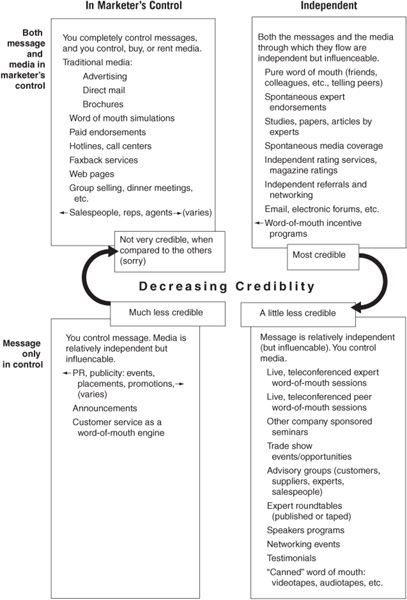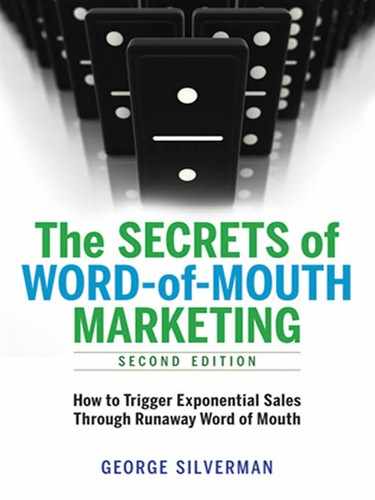CHAPTER 14
Which Methods Work
Best for What? A Word-
of-Mouth Checklist
Sources and Delivery Mechanisms
By “method,” I mean sources and delivery mechanisms, which often cannot be separated. As you have probably guessed, no one particular word-of-mouth method works best in every circumstance. Some of the least effective in one kind of situation work spectacularly well in other circumstances. Often, the least effective applicable word-of-mouth method can create more sales than the best of the other marketing methods. Word of mouth is simply in a different league from advertising, sales, or promotions. Figure 14-1 illustrates the relative credibility of word-of-mouth delivery methods.
This is a necessarily partial list, since new methods are being invented almost daily. They are often up one level of abstraction, ranked roughly from generally most to least effective. Remember that we are talking about a word-of-mouth campaign here. Since you should be using as many of these elements as you can, ranking may be irrelevant. In decreasing order, with the most influential method listed first, they are:
Figure 14-1
Relative credibility of word-of-mouth delivery methods

![]() A trusted adviser recommending that a person use the product
A trusted adviser recommending that a person use the product
![]() A top rating by an advisory or rating service
A top rating by an advisory or rating service
![]() A friend telling a friend (in person, by phone, and increasingly by email)
A friend telling a friend (in person, by phone, and increasingly by email)
![]() People giving you a reference, referral, or otherwise networking
People giving you a reference, referral, or otherwise networking
![]() Expert/peer word-of-mouth seminars
Expert/peer word-of-mouth seminars
![]() Experts’ roundtables
Experts’ roundtables
![]() Experts and customers quoted in articles recommending the product (PR)
Experts and customers quoted in articles recommending the product (PR)
![]() Influencers’ blog posts, speeches, papers, studies, and other endorsements.
Influencers’ blog posts, speeches, papers, studies, and other endorsements.
![]() Podcasts of experts and peers endorsing a product (infomercial style)
Podcasts of experts and peers endorsing a product (infomercial style)
![]() Advisory groups
Advisory groups
![]() User groups—Listservs, forums, other social networking, etc.
User groups—Listservs, forums, other social networking, etc.
![]() Networking at conferences, association meetings, or seminars
Networking at conferences, association meetings, or seminars
![]() Product seminars conducted by a nonsalesperson at a company
Product seminars conducted by a nonsalesperson at a company
![]() Events—such as dinner meetings, swap-meets, barbecues, or rallies—mixing customers and prospects
Events—such as dinner meetings, swap-meets, barbecues, or rallies—mixing customers and prospects
![]() Conspicuous usage by supercompetent people, product placement.
Conspicuous usage by supercompetent people, product placement.
![]() Quotes from real customers in print ads, mailings, brochures, or commercials
Quotes from real customers in print ads, mailings, brochures, or commercials
![]() Quotes from experts in print ads, mailings, brochures, or commercials
Quotes from experts in print ads, mailings, brochures, or commercials
![]() The company president talking to you in a commercial
The company president talking to you in a commercial
![]() Celebrity endorsements
Celebrity endorsements
![]() Actors portraying customers in ads
Actors portraying customers in ads
![]() Actors portraying experts (such as doctors) in ads
Actors portraying experts (such as doctors) in ads
Word-of-Mouth Checklist
To help determine what are the most effective, simple things that can be done to increase your word of mouth and ultimately increase your sales, ask the following questions:
![]() Are all of your communications sending the same simple message? It can’t generate and survive word of mouth unless it’s simple and unless it’s a compelling story.
Are all of your communications sending the same simple message? It can’t generate and survive word of mouth unless it’s simple and unless it’s a compelling story.
![]() Is your product positioned as part of a general class, then differentiated on the basis of its most needed attribute? That’s the way people hold things in their heads: “The dandruff shampoo that doesn’t dry your hair,” “The cereal that adults have grown to love,” “The luxury 4-wheel drive.” If you can’t state your product’s core essence in such succinct terms, chances are your customers will not be able to describe your product either. And if your product can’t survive word of mouth, it probably can’t survive at all.
Is your product positioned as part of a general class, then differentiated on the basis of its most needed attribute? That’s the way people hold things in their heads: “The dandruff shampoo that doesn’t dry your hair,” “The cereal that adults have grown to love,” “The luxury 4-wheel drive.” If you can’t state your product’s core essence in such succinct terms, chances are your customers will not be able to describe your product either. And if your product can’t survive word of mouth, it probably can’t survive at all.
![]() Are your examples outrageous enough to be repeated? Is there any earthly reason for people to repeat your story?
Are your examples outrageous enough to be repeated? Is there any earthly reason for people to repeat your story?
![]() Do you sprinkle your materials with success stories from real people?
Do you sprinkle your materials with success stories from real people?
![]() Are you using experts fully in ways that are objective but effective?
Are you using experts fully in ways that are objective but effective?
![]() Have you created mechanisms so that people can follow up on the word of mouth they hear: simple and multiple ways of inquiring, investigating, ordering?
Have you created mechanisms so that people can follow up on the word of mouth they hear: simple and multiple ways of inquiring, investigating, ordering?
![]() Have you made the decision process—i.e., the collection of information, confirmation, trial, and rollout—so easy that your customer does not have to exert any effort?
Have you made the decision process—i.e., the collection of information, confirmation, trial, and rollout—so easy that your customer does not have to exert any effort?
![]() Have you created events and mechanisms so that once your prospect hears about your product, it is easier to try or buy than to stay with the frustration and uncertainty of unfulfilled desire?
Have you created events and mechanisms so that once your prospect hears about your product, it is easier to try or buy than to stay with the frustration and uncertainty of unfulfilled desire?
![]() Advertising: Do you have success stories from real people in at least some of your ads? How about quotations from customers and experts? Have you tried giving information that people can rip out and give their friends? How about offering useful booklets or invitations to events such as seminars? There are dozens of ways of increasing word of mouth through advertising if you make it a primary objective, not an afterthought or a non-thought!
Advertising: Do you have success stories from real people in at least some of your ads? How about quotations from customers and experts? Have you tried giving information that people can rip out and give their friends? How about offering useful booklets or invitations to events such as seminars? There are dozens of ways of increasing word of mouth through advertising if you make it a primary objective, not an afterthought or a non-thought!
![]() Sales: Have you trained your salespeople how to get referrals, recommendations, and testimonials? Do you know how to “work the booth” at trade shows? Do you have a program that teaches your salespeople how to master these activities? Do you have a referral system in place—a rewards system for getting and making referrals? Are you making use of the word of mouth among your sales force? What are they telling one another? Are they getting turned on? Turned off? Are you making use of the positive word of mouth of your most successful salespeople in order to motivate your less successful salespeople? Are you taking advantage of the word-of-mouth opportunities at trade shows?
Sales: Have you trained your salespeople how to get referrals, recommendations, and testimonials? Do you know how to “work the booth” at trade shows? Do you have a program that teaches your salespeople how to master these activities? Do you have a referral system in place—a rewards system for getting and making referrals? Are you making use of the word of mouth among your sales force? What are they telling one another? Are they getting turned on? Turned off? Are you making use of the positive word of mouth of your most successful salespeople in order to motivate your less successful salespeople? Are you taking advantage of the word-of-mouth opportunities at trade shows?
![]() Direct mail: Are you asking for referrals from your customers? Have you identified your most enthusiastic customers and offered them special incentives to refer their colleagues? Are you taking advantage of the other opportunities mentioned above, particularly customer stories, case studies, and the like? Are you offering customers something genuinely valuable, such as a useful booklet and getting their colleagues’ names to add to your recipient list?
Direct mail: Are you asking for referrals from your customers? Have you identified your most enthusiastic customers and offered them special incentives to refer their colleagues? Are you taking advantage of the other opportunities mentioned above, particularly customer stories, case studies, and the like? Are you offering customers something genuinely valuable, such as a useful booklet and getting their colleagues’ names to add to your recipient list?
![]() Internet: Are you taking advantage of the myriad opportunities for networking, interactive information, and other word-of-mouth opportunities offered by this medium—the most important word-of-mouth medium ever invented?
Internet: Are you taking advantage of the myriad opportunities for networking, interactive information, and other word-of-mouth opportunities offered by this medium—the most important word-of-mouth medium ever invented?
![]() Service: Are you viewing customer service—which is much, much broader than fixing broken product—as a branch of marketing, as an opportunity center instead of a cost center? Are you going to extraordinary lengths to satisfy people, so that they will talk about how well you took care of them?
Service: Are you viewing customer service—which is much, much broader than fixing broken product—as a branch of marketing, as an opportunity center instead of a cost center? Are you going to extraordinary lengths to satisfy people, so that they will talk about how well you took care of them?
![]() In general: Is your entire marketing program oriented toward generating, encouraging, and amplifying every word-of-mouth opportunity possible? It’s easy to get people to talk about the out-rageous, and it’s easy to be responsibly, professionally outrageous.
In general: Is your entire marketing program oriented toward generating, encouraging, and amplifying every word-of-mouth opportunity possible? It’s easy to get people to talk about the out-rageous, and it’s easy to be responsibly, professionally outrageous.
If you are not yet looking at your entire marketing program from a word-of-mouth perspective, you have a megaopportunity to impact your sales dramatically, quite possibly to levels several times beyond their present numbers.
